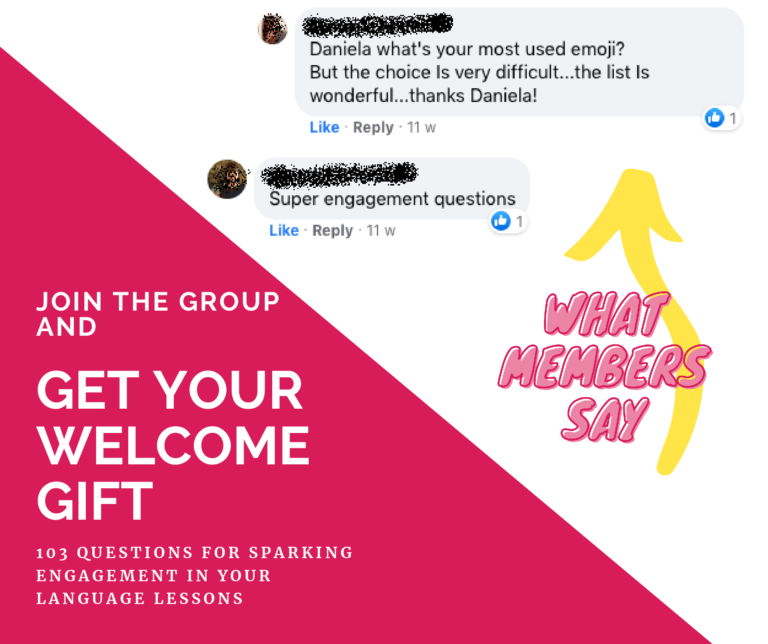
There are two, fundamental second language acquisition strategies, better known as approaches: the deductive approach and the inductive approach. Only one of those two teaching strategies in second language acquisition paces our brains pattern when they absorb new input and they develop new skills. In this article you are going to learn about the learning cycle and how this reflects in second language acquisition.
Especially when language teachers have just started out, they may be confused about the strategies we can apply in second and foreign language acquisition. Let’s get clarity on this fundamental topic, then.
In this article I’m going to answer the following key questions:
- What are the second language acquisition strategies?
- How should we choose the right strategy?
- How do those strategies work?
- Which is the most effective strategy in second and foreign language teaching?
Clarified that, because I LLLLLOVE when teachers take action, you can dive into the implementation of what you’re going to explore below starting from today. It’s easy and fun: just grab your free guide in the top 5 strategies for getting your students to speak and engaged and follow the tips for taking action and getting the results you want from your very next lesson:
What are the second language acquisition strategies?
There are two fundamental second language acquisition strategies or, better said, two approaches languages teachers can refer to:
- deductive approach
- inductive approach
The deductive approach is a teaching approach that focuses on the grammar as a starting point for learning the target language. Also, this is a teacher-centred approach, meaning that the teacher shows the new information and the students will practise to put it into use. Learning is the outcome of formal instruction and its goal is to build conscious knowledge ‘about’ the language, for example knowledge of grammar rules.
The inductive approach is a teaching approach that focuses on the communicative act and it is student-centred, meaning that the teacher gives the new information, such as lexis or grammar structures, within a communicative context and the learners will guess what that means and how it works. The inductive approach triggers a subconscious process that leads to acquisition.
Here comes the distinction made by Prof. Stephen Krashen between learning and acquisition:
- Learning is the outcome of formal instruction (aka deductive approach)
- Acquisition is the outcome of a subconscious process (aka inductive approach).
All other teaching strategies in second language acquisition come from those two approaches.
How should we choose the right strategy?
According to Krashen, acquisition should be the goal any language teachers should aim at. In the past, the deductive approach was the only commonly recognised approach, whilst nowadays the inductive approach is widely applied since it’s been recognised as the most effective between the two teaching strategies in second language acquisition. Nevertheless, the deductive approach is still the only teaching strategy many teachers know and that they can apply: think about the majority of the language lectures at the university, for instance.
That said, it’s up to you to choose which approach to stick to. In my opinion, the inductive approach is definitely winner because it enables the teachers to take the students to:
- To develop real communication skills (rather than only a theoretical knowledge about the target language)
- To become able to use the target language for communicating with other people and for expressing themselves
- To long-lasting memorisation and to self-efficiency
- To enjoy learning the target language and, therefore, to become more and more self-efficient as learners and progressively more aware of the cultural implications that learning a language has.
This doesn’t mean that within the inductive approach we can’t find moments where we explain the grammar, of course. Even in the suggestopedic courses, where the whole approach is totally based on the use of art, drama and games, the suggestopedic teachers analyse the mechanisms of the target language every now and then, although they do that only at the end of the didactic unit.
So, the key question that should guide your choice is: do I want to produce learning or acquisition?
How do those second language acquisition strategies work?
From the neurological point of view, learning and acquisition are different.
Learning, the output of the deductive strategy, takes new input (what we learn) to get stored within the working memory. On the contrary, acquisition, the output of the inductive strategy, takes new input to the long-term memory.
Why is that? Because learning is the output of formal instruction, it’s logical and rational. Whilst acquisition is the output of communicative involvement, it paces a natural cycle that takes place whenever our brains are exposed to new input and they absorb it.
Here below you can find the two teaching strategies in second language acquisition in practice. You’re going to look at the lesson structures and stages according to the two different approaches.
The deductive approach stages are:
- Teacher explains grammar structures, the rules and how they work
- Students listen to the explanation and try to put those rules into use through structured exercises and drilling
- Eventually, the teacher asks the students to put those structures into use when they speak and write, by combining those structures with the vocabulary they know.
The inductive approach stages are:
- Teacher exposes the students to stimuli (images, videos, dialogues, etc.) and communicative contexts within which they come across new input (be it grammar structures or vocabulary)
- Teacher invites the students to notice the new input, to use it intuitively
- Afterwards, the students try to work out what the new input is and how it works: they arrive to a formal explanation of the new input by themselves and by intuitively making links
- Students practise the new input to consolidate their comprehension in different contexts and to explore all aspects related to that new piece of information
- Eventually, students produce spoken and written discourses for practising the new input within proper communicative contexts.
If you were looking for the golden post about the best teaching strategies in second language acquisition, you got it: it’s not a big list of strategies that you need. In fact, the “mother” strategies are only two and the structure of the lesson is exactly the one you can find above.
Which is the most effective strategy in second and foreign language teaching?
As you might have noticed thanks to the explanation above, the inductive approach starts from engaging the students with the lesson through something that can tease their interest.
On the contrary, in the deductive approach the students’ engagement is not taken into consideration: in this case, the teachers take for granted the students will spontaneously get engaged because they need to learn the proposed content! – Good luck with that!
Hence, the most effective of the two second language teaching strategies is the inductive approach. It produces true acquisition and it gets the students spontaneously engaged.
Start today to promote acquisition, to engage your students with your lessons and to spark motivation: download the Top 5 easy-to-implement strategies for getting your students to speak and engaged!
Want more support?
Join the Facebook group Independent Language Teachers Collective to get daily advice, tons of free training and to branch out with other independent language teachers like you!
ALSO…
Available only for the Collective members: free list 103 question for sparking engagement in your language lessons.
This is what members say about the freebie:

Join in the Collective and grab your welcome gift:
Join Facebook Group

